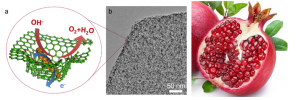 The topics of climate change and the energy crisis are on the minds of many scientists working in the fields of energy storage and conversion. When looking toward the future, the development of more efficient and effective energy storage technologies is critical. Instead of our traditional “carbon cycle,” researchers are beginning to focus on the “hydrogen cycle” as a promising alternative.
The topics of climate change and the energy crisis are on the minds of many scientists working in the fields of energy storage and conversion. When looking toward the future, the development of more efficient and effective energy storage technologies is critical. Instead of our traditional “carbon cycle,” researchers are beginning to focus on the “hydrogen cycle” as a promising alternative.
With this, there been a lot of focus on water-splitting techniques. However, there are many challenges that this technology has to overcome before it reaches efficient levels on a large scale.
In order to help address complications associated with water-splitting, ECS member Qiang Zhang is leading a research group from Tsinghua University to help get closer to the ultimate goal of the “hydrogen cycle” by developing a novel graphene/metal hydroxide composite with superior oxygen evolution activity.
This from Tsinghua University:
On one hand, graphene is a material that exhibits ultrahigh electrical conductivity, high surface area, and tunable 3D structures, which is excellent for heterogeneous electrocatalysis. However, the intrinsic activity of graphene is undesirable. On the other hand, NiFe layered double hydroxides (NiFe LDHs), with remarkable catalytic activity, high stability, earth-abundant and environmental benign characters, are regarded as the most promising nonprecious metal catalysts.
“Therefore, the fine control of NiFe LDH hybridization into a specific graphene substrate to obtain an increased electrochemical active surface area (ECSA), fully exposed active sites, and an optimal interfacial junction is the most promising recent topic towards superior oxygen evolution catalysis and practical application,” Prof. Zhang says.
A simple pomegranate was the inspiration of the hierarchical structure, which optimizes the hybridization between NiFe LDHs and graphene.
“I believe that this strongly-coupled complex has various applications such as heterogeneous catalysis, sensors, energy conversion and storage,” says Prof. Zhang. “And more importantly, the topology-assisted design and fabrication strategy opens up new avenues and sheds light on a novel branch of advanced nano-architectured materials and hybrids.”
Join Zhang and other brilliant scientific minds by becoming a member of ECS today!
PS: Interested in energy conversion and storage? Make sure to attend the ECS Conference on Electrochemical Energy Conversion & Storage with SOFC-XIV this July!


